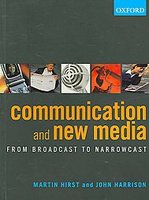 Martin Hirst and John Harrison — Communication and New Media: From Broadcast to Narrowcast
Martin Hirst and John Harrison — Communication and New Media: From Broadcast to Narrowcast
South Melbourne, Oxford University Press, 2007
ISBN 9780195553550
There is a lot to admire about the breadth of coverage of topics, the accessibility of the arguments, and the degree of complexity embraced within the scope of this book. The depth and range of material presented is located within an orthodox political economy model of communications, which provides a solid essentially historical mode of analysis for assessing and critiquing the “fields” of publicly mediated communications. It stays close to the established categories of public communications and journalism, somewhat at the expense of less obviously worthy entertainment media genres and popular production modes.
The depth of scholarship from the Global South perspective of Australia makes this a worthy general course reader for a broad-based, public communications study, but difficulties with the book for this reviewer begin with the title. Presumably intended as an indicator of currency, the need to append “New Media” to a book on communications suggests a view that the newer media are still considered something of an add-on to the real work and impact of communications. The use of the term “broadcast” in the sub-title provides a strong focus, although it is increasingly seen as a dated communications paradigm at this transitional time. For example, the B-word is generally unspoken when referring to or describing the still essentially broadcast based operations of the ABC, BBC, CBC, PBS public media organisations. It does provide a solid core to the text as the notion of broadcasting still carries a great deal of force as a marker of cultural meaning, as it remains a central element of identification with those public media institutions, and hence serves as a powerful professional and institutional determinant of standards of quality and relevance (or lack of, for some younger people) in the electronic media. However the term “linear media,” as in “linear” television and radio, as opposed to their recent user-centred online variants, suggests a more current descriptor for what has previously been termed “broadcast” television or radio. Similarly the use of “narrowcast”, like its more recent equivalent online term “broadcatching”, largely fails in attempting to bridge the old and new communications vocabularies, never quite capturing the degree of shift implied in, say, the term “Social Media”, for describing what is “the new” aspect of recent media developments.
But the main concern here is in the authors’ description of the book as “an introduction to contemporary theories and views about mass communication and the mass media.” The emphasis upon “mass” may be an attempt to distinguish it from the interpersonal, organisational and professional braches of communications studies, and hence a calculated delimitation produced through the artificial fragmentation of communications curricula, and the administrative processes which envelope them. It will distance those uncomfortable with the “mass” conception of communications and media studies. It certainly distances it from the recently perceived implosion of many aspects of the operational and social applications of digital communications technologies. The “mass” audience, if it ever existed, is currently dispersed across a broad spread of multiple platforms. As such, the book projects a characteristic “mass com” distance from the objects of study in the actual artefacts transmitted via the communications systems studied, a task traditionally allocated to the closer textual and transactional engagement of media studies. A good deal of the distance implied in this approach is also a reflection of the recent debates around the notion of “Media Studies 2.0”, as articulated by David Gauntlett in the UK, which are about relocating the study of communications media beyond the dichotomising of old and new approaches to studying media and communications.
Although this review may smack of criticising the book for what it is not, the allegiance to an older “mass” conception of communications structures, processes and consumption, inevitably means the account of the contemporary state of the communications media is further filtered through a “convergent” model of recent developments. Admittedly still a dominant notion, convergence has been a useful retrospective means of explicating structural change in the media in the past decade or two, especially those shifts in the ownership and organisation of the previously relatively separate sectors of the information, communication and media industries, but it is increasingly unhelpful as a model for looking forwards across the emerging plane of technologically mediated communications, with the shift to “engagement cycles” and the building of social capital at the core of a more diversified contemporary communications operations portfolio.
Hirst and Harrison do, it has to be said, usefully set their text against the background of a fragmentation of media, and their changing “form and function in response to digital convergence”, but appear somewhat sceptical about the role which interactivity can play in this changing communications technological environment brought about by digitalisation. Again, this reinforces the convergent “casting” theoretical model being applied to the analysis of new developments rather than reflecting an emergent model, predicated upon the existence of a significantly new communications environment.
Dr. Peter Dallow is a lecturer at the University of Western Sydney

